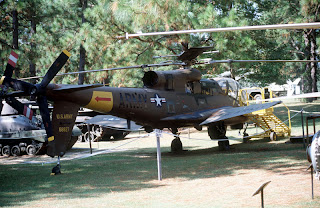Designation: Lockheed AH-56 Cheyenne
Classification Type: Attack Helicopter Prototype
Contractor: Lockheed - USA
Country of Origin: United States
Initial Year of Service: 1967
Number Built: 10
Operators: United States
The Lockheed-designed and produced AH-56A attack helicopter was a failed
attempt at the United States Army's AAFSS (Advance Aerial Fire Support
System) requirement. Designated the "Cheyenne", the aircraft represented the
most advanced helicopter design of the time and it would be this very
accolade that would become the systems undoing.
The AH-56A was produced into ten working prototypes. The aircraft was built
around a single General Electric turbine capable of generating 3,435
horsepower while powering a rigid main rotor element and two tail rotor
elements housed on the tail assembly. The rear rotor assemblies featured a
very distinct anti-torque tail rotor coupled with a three-blade "pusher".
The unique design of the overall system added a specific identity to the
aircraft.
The system was controlled by two crewmembers seated in tandem. Landing gear
systems were fully retractable and the aircraft featured an integrated
laser-range finder linked to a fire control computer. One of the more unique
elements of the design revolved around the swiveling XM112 gunner's station
that was linked to the belly and nose turrets.
The belly turret was armed with an XM52 30mm automatic cannon while an XM51
40mm grenade launcher or an XM53 7.62mm gatling gun could be fitted in the
chin-turret. Additional wing-mounted armament was to include the TOW
anti-tank missile system and XM200 2.75 inch rocket pod launchers.
The first prototype of the AH-56 first flew on May 3, 1967 and could reach
speeds of over 240 miles per hour. Rising development costs, delays in
development and the arrival of two other viable alternatives to the AH-56
produced by Bell and Sikorsky forces the entire program to be effectively
cancelled on August 9, 1972. Only ten AH-56 Cheyenne prototypes would ever
be produced with several conducting powered flights and weapons testing.
In the end, the Army realized it had needed a less complicated combat system
with the agility of a light helicopter. The integrated fire control and
navigation systems would also have to be of the low-maintenance variety,
leading up to the designation of the new Advanced Attack Helicopter (AAH)
initiative. The Boeing Corporation (through McDonnell Douglas) would
eventually step in with what was to become the recognizable AH-64 Apache
series. The United States Army, already embroiled in the Vietnam conflict in
Asia, would settle on the AH-1 HueyCobra for the duration of the war,
partnered with militarized armed versions of the UH-1 Huey transport
helicopters known as gunships.
Specifications for the Lockheed AH-56A Cheyenne
Dimensions:
Length: 60.04ft (18.30m)
Width: 25.92ft (7.90m)
Height: 13.78ft (4.20m)
Performance: About MACH
Max Speed: 245mph (395kmh; 213kts)
Max Range: 629miles (1,013km)
Rate-of-Climb:3,420ft/min (1,042m/min)
Service Ceiling: 25,997ft (7,924m; 4.9miles)
Structure:
Accommodation: 2
Hardpoints: 4
Empty Weight: 11,718lbs (5,315kg)
MTOW: 16,995lbs (7,709kg)
Powerplant:
Engine(s): 1 x General Electric T64-GE-16 turbine engine generating 3,435hp.
Armament Suite:
1 x XM51 40mm grenade launcher OR 1 x XM53 7.62mm gatling minigun mounted in
a chin-turret assembly.
1 x XM52 30mm automatic cannon mounted in a belly turret.
Fuselage mounted armaments were to include:
TOW anti-tank missiles
XM200 2.75 inch rocket launcher pods









No comments:
Post a Comment